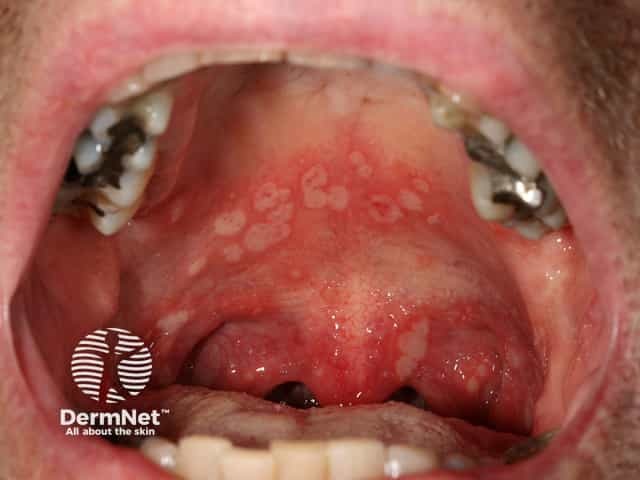Main menu
Common skin conditions

NEWS
Join DermNet PRO
Read more
Quick links
Introduction
Causes
Demographics
Clinical features
Diagnosis
Treatment
Herpangina is the name given to painful mouth and throat ulcers due to a self-limited viral infection and usually occurs in childhood.

Herpangina

Herpangina is an enterovirus infection – these are viruses that infect the gastrointestinal tract. Herpangina is usually spread by the faecal-oral route and the virus may continue to be excreted in the faeces long after the illness has recovered. Spread may also occur via respiratory and oral-oral routes or possibly via contaminated fomites (things such as towels, cups etc.) and fresh water. The incubation period is approximately 4 days.
It is usually caused by coxsackie A16 virus and is highly contagious. Other common coxsackie A viruses isolated from herpangina are A1-10, 12 and 22. Less common causes are coxsackie B1-5, echoviruses, enterovirus 71, herpes simplex virus, parechovirus 1 and adenoviruses. Approximately 50% of enterovirus infections do not result in a clinical illness and these people are another source of infection without realising it.
Long lasting immunity develops to the specific virus after recovery. However it is possible to have a second attack of herpangina due to an unrelated virus.
Herpangina is seen mainly in children up to 10 years of age, but may affect all ages from infants through to young adults. It is particularly common in children attending childcare facilities. In some epidemics a slight male predominance has been reported. Infection rates peak in summer and early autumn in temperate climates, but occur year round in the tropics. Epidemics tend to occur every 2-3 years when a new group of nonimmune young children become susceptible.
Fever (38.5-40C) is usually the first sign of infection with a general feeling of being unwell.
Sore throat and pain on swallowing develop. Red spots appear within hours (up to one day later) in the mouth and throat. The red spots become raised into small blisters (vesicles) which form a tiny yellowish ulcer with a red rim. These are the lesions called ‘herpangina’. The ulcers are generally 1-2mm (<5mm) in diameter. There are usually not many lesions (range 2-12). They are seen most commonly at the back of the mouth and throat such as on the soft palate, tonsils, uvula and back of throat. The mouth, throat and skin otherwise look normal. The ulcers take 5-10 days to heal, sometimes after the fever has settled.
Lymph glands in the neck can become enlarged and may be felt as firm smooth swellings on both sides of the neck.
Headache, backache, abdominal pain, vomiting and loss of appetite may be reported.
Herpangina is generally a mild self-limited infection, but rarely more serious neurological, heart and lung problems may complicate some enterovirus infections. Although enteroviruses are not believed to cross the placenta, some studies suggest maternal coxsackievirus infection may cause miscarriage or affect the developing baby.
The diagnosis of herpangina is usually made clinically without the need for special tests. The typical symptoms with lesions at the back of the mouth and throat in a child in summer or autumn will make the diagnosis.
The virus can be isolated from nasopharyngeal swabs and also from urine, faeces and blood, as it is a systemic infection. Blood tests are usually within normal ranges. Biopsy of an ulcer does not show specific pathology. Serology will show a rising titre of specific antiviral IgM antibodies, first appearing after 1 week. The IgM antibodies persist for about 6 months and are replaced by specific IgG. However tests would not usually be required in an uncomplicated case of herpangina.
Herpangina can be distinguished from hand, foot and mouth disease, another enterovirus infection, by the lack of skin lesions. Primary herpes simplex virus infection of the mouth is usually more extensive including the gums, is very painful and lasts longer.
There is no specific therapy for herpangina and treatment is therefore symptomatic. Paracetamol may be taken for fever and pain. Because of the fever and pain on swallowing, it is important to encourage sufficient fluid intake. Cold milk or water, ice cream and ice blocks are suitable. Hot drinks and fruit juices should be avoided because of the painful ulcers. Dehydration is probably the commonest complication of herpangina.
It is important to seek further medical advice if the illness does not improve in 1 week or if there is a deterioration or development of new symptoms.